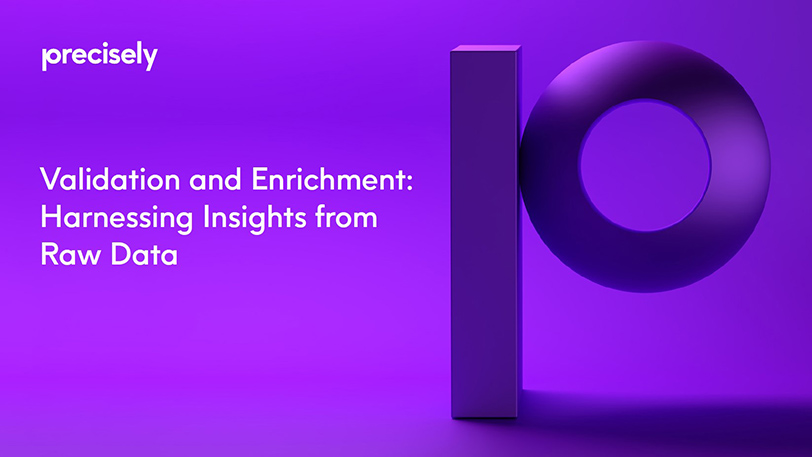eBook
Validation and Enrichment: Harnessing Insights from Raw Data
Introduction
In today’s fast-paced global economy, where consumers are accustomed to getting what they need virtually at a moment’s notice, failed deliveries or improper billing due to poor quality data results in a loss of business. Without complete and reliable data, companies may rely on guesswork or partial information, leading to poor decision-making, hampering market analysis, and slowing growth opportunities.
Data is the lifeblood of modern businesses, driving decision-making, strategy development, and operational efficiency. However, the effectiveness of data-driven initiatives relies heavily on the quality and integrity of the underlying data.
In this ebook, we delve into the crucial data validation and enrichment process, uncovering the challenges organizations face and presenting solutions to simplify and enhance these processes.

Data validation
In an ideal world, your company would have access to reliable and consistent data that provides meaningful context to answer the most pressing questions businesses are asking. Despite the need for insightful data, a recent result from the 2023 Survey of Data and Analytics Professionals reveals that 77% of respondents value data-driven decision-making yet operate in an environment where resources are constrained, trust in data is low, and data quality challenges impact all aspects of data integrity.
How can your business start a data integrity journey and transform raw data into meaningful insights?
Increasing data quality is the most prevalent need every company faces today; how can a company trust its data if it is incomplete, inaccurate, or provides no business value? Data validation helps to improve:
- Accuracy: Identify and rectify inaccuracies within the data by comparing the entered or imported data against predefined rules, such as data type, range, or domain constraints; validation can flag errors, such as incorrect values, missing information, or inconsistent data formats. Does an email contain the ‘@’ symbol?
- Completeness: Ensure that all required fields are populated and contain the necessary information. By checking for missing or null values, validation helps maintain data completeness. Incomplete data can lead to skewed analysis, hinder decision-making, and affect the reliability of data-driven applications. Does the first name have a last name attached?
- Consistency: Enforce consistency by verifying that data elements are in harmony with each other and follow defined relationships or dependencies. For example, if you have a title for a contact in the marketing system, then you would it would be consistent to have the same title for that contact in the sales system. Consistent data supports reliable reporting, analysis, and application functionality.
- Conformity: Validation ensures data adheres to predefined standards, regulations, or business rules. It helps identify data not complying with specified formats, patterns, or validation rules. This is particularly important in scenarios such as data integration, where data from various sources must conform to a unified structure or standard. Enforcing data conformity reduces errors, enhances interoperability, and facilitates data exchange.
- Error Prevention: Prevent errors at the data entry or import point. Validating input against predefined rules can prompt users to correct mistakes, improving data quality from the outset. This proactive approach minimizes the chances of data inconsistencies or inaccuracies downstream and reduces the effort required for data cleansing and correction later on.

In the same 2023 Survey of Data and Analytics Professionals, 41% of respondents said that the biggest challenge keeping their organization from effectively using location data for decision-making is that address data needs to be standardized, verified, and fit for purpose. When internal data systems aren’t connected, they are not collecting all the information a business needs and need to be organized in the manner required for analytics. That means that maintenance and enhancement processes are complicated, they’re complex, prone to errors, and very lengthy. A business can’t react as it wants to due to slowness, and it often can’t deliver the services and features that their customers expect to see from an organization, putting their overall growth at risk and threatening critical goals as a business.
Transforming raw data into actionable insights is challenging for many organizations across industries. But the need to turn that issue around has never been more vital, thanks to a digital landscape that increasingly values context and personalization, and often more than clean and validated data is needed to rise to the challenge.

The Power of Data Enrichment
What makes data enrichment so powerful? It allows your business to dive deeper into customer insights, which empowers more informed decisions, optimized business processes, inspired product innovation, and personalized marketing messages. But what is data enrichment, exactly? It’s the process of enhancing your data by appending relevant context from additional sources – improving its overall value, accuracy, and usability.
Companies generate vast quantities of first-party data about their customers and their operations. But businesses also depend on external third-party data to learn more about their customers so they can create rich omnichannel marketing campaigns and help sellers take the next best action. Or, for example, they use external data to help evaluate business risk, ensure compliance, make informed planning decisions, or select the right location for stores, restaurants, and infrastructure.
The uses of enrichment data are virtually unlimited. The challenge is finding the right data and data sources for meeting your business goals. Whether you are using third-party data for business intelligence dashboards, problem-solving, analytics, or AI/ML applications, your results will depend on the quality of the data you use or the data providers you select.
As with data validation, high-quality data enrichment aims to enable access to trusted data throughout the organization. But data professionals spend about 80% of their time finding, prepping, and managing data1 today. That leaves only about 20% of the workday for applying data to business operations: running models to illuminate risks and opportunities, creating efficiencies, enhancing the customer experience, and improving business outcomes.
What if you could flip those ratios?
What if your staff could easily select, incorporate, enrich, and interact with data — your own, and that developed by third parties? What perspectives would you gain? What business opportunities would you uncover?
A persistent ID to simplify complexities
Gaining ready access to trusted, easy-to-use data can feel like a complicated process. It requires time, resources, and specialized tools and skills to access data from siloed, back-end systems. Then, cleansing and standardizing that data and enriching it with context can reveal critical relationships previously missed by incomplete and messy data. Joining datasets using addresses as property identifiers can be challenging.
Addresses can act as linkage points for establishing location and connecting data. But addresses are complex and often provide an incomplete view of the location.
Different administrative bodies — from municipalities and developers to postal authorities — are responsible for various address components. Any one of those entities may change part of the address name. A single old mansion may be divided into apartments. An individual condo owner may buy two units and combine them. New addresses arise as a result.
Furthermore, while a physical address is vital to postal delivery, it does not indicate where a property sits relative to other locations — flood plains, specific tax districts, or the nearest fire station.

You may want to work with a data partner who uses unique, persistent identifiers to label properties. These identifiers can enable data stewards to amend thousands of data points to specific geolocations based on latitude and longitude. This process leads to a deeper understanding of each property. Think about it this way. It’s good to know that there’s a mixed-use building at 100 Main Street. Attaching parcels, building footprints, attributes, demographics, and socio-economic data to that building is even more informative. Unique, persistent identifiers help in this effort.

The Precisely difference
Precisely is the global leader in data integrity, providing accuracy and consistency in data for 12,000 customers — including 99 of the Fortune 100 — in more than 100 countries. Precisely’s data integration, quality, governance, location intelligence, and enrichment products power better business decisions to create better outcomes.
Building on more than 20 years of data-domain expertise, our products and services enable our customers to spend more time using data to improve business outcomes, and less time sourcing, preparing, quality checking, and updating information.
We believe working with a data provider you trust is vital. We understand this need. We’ve experienced it ourselves. Our products are built on data from more than 100 suppliers. Our work evaluating these suppliers saves you the time and complexity of vetting them yourself. The result? Hundreds of interoperable datasets, including customized datasets, are designed to meet your needs. Precisely solutions have multiple delivery and deployment options available to meet your needs. We also recognize you may have an investment in other technologies but rest assured – we can meet your data validation and enrichment needs wherever your data lives, while you continue to leverage your current investments.
Creating linkages is an integral part of any data effort. For this, we offer PreciselyID. PreciselyID is a unique and persistent identifier, based on a property’s latitude and longitude. It can enrich geolocations with more than 9,000 attributes. PreciselyID also allows companies to easily update, correct, and process records in bulk. This saves you processing time and expense and increases overall data value and accuracy.
Easy to deploy, use, and manage, Precisely solutions combine outstanding flexibility with the power of high-volume processing. They leverage Precisely’s Enrich product portfolio, other third-party data, as well as your own internal data to keep pace with rapidly changing business requirements.
Take your business further with data quality solutions that power bigger and better outcomes.
Transforming data into actionable insights should be simple

Ready to see how you can harness insights from raw data?
Get in touch to learn how Precisely can help.